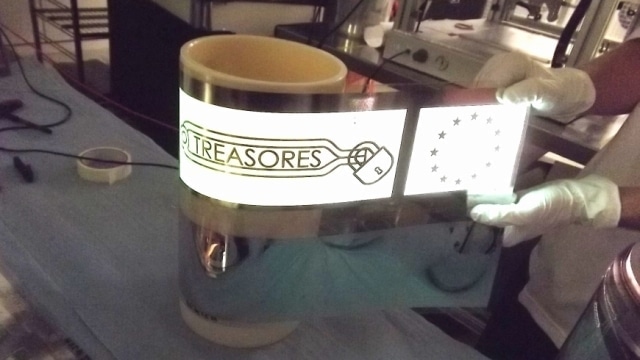Mar 8 2016
European scientists have successfully developed future lighting technology commercially ready. The breakthrough is the result of more than three years of dedicated research. The team created flexible lighting foils, which can be produced in a roll-to-roll fashion, similar to the way newspapers are printed. These devices hold the potential to develop low-cost LED lighting panels and solar cells.
 Flexible OLED light sources on transparent electrodes developed within TREASORES. These OLEDs were made by Fraunhofer FEP using a roll-to-roll process. (Image: Fraunhofer FEP).
Flexible OLED light sources on transparent electrodes developed within TREASORES. These OLEDs were made by Fraunhofer FEP using a roll-to-roll process. (Image: Fraunhofer FEP).
In November 2012, the TREASORES (Transparent Electrodes for Large Area Large Scale Production of Organic Optoelectronic Devices) project was launched to develop next-generation technologies, in order to reduce the manufacturing costs of LED lighting panels, solar cells, and other organic electronic devices. The European Commission has granted 9 million Euro to fund this initiative, with a further 6 million Euros donated by project partners. Since then, the project has produced a dozen peer-reviewed publications, seven patent applications, and provided input to organizations at international levels.
New transparent electrodes and barrier materials
The projects most important contribution is the development and scale up of manufacturing processes for new barrier materials and transparent electrodes, to be used in advanced flexible optoelectronics. Three electrodes-on-flexible substrates, using thin silver, metal fibers, or carbon nanotubes, are either anticipated to start production this year or already being developed at a commercial scale. Tests were conducted on the new electrodes with different types of optoelectronic devices, using rolls measuring more than 100 m in length. The electrodes have demonstrated that they are suitable for sophisticated solar cells and light sources.
The roll of OLED light sources, featuring the project logo, were created at Fraunhofer Institute for Organic Electronics, Electron Beam and Plasma Technology (Fraunhofer FEP). This was achieved by employing roll-to-roll methods on a thin silver electrode, which was originally developed by Rowo Coating GmbH for the project.
Flexible light sources for cheap and nice illumination
The innovative processing methods hold potential to make solar cells and light sources less expensive in the future. This would require the use of transparent and flexible electrodes, with barrier materials that are water resistant. The latter product was also produced within the TREASORES project.
The newly developed electrodes are technically as good as electrodes used currently, made from indium tin oxide, but they are relatively cheaper to produce and do not depend on the use of indium. Tomasz Wanski of Fraunhofer FEP informed that thanks to the new electrodes the OLED light source is uniform across a large area, and attain an efficiency of 25 lumens/W, which is as good as the relatively slower sheet-to-sheet manufacturing process used to produce similar devices.
During the TREASORES project UK-based National Physical Laboratory devised new testing techniques to ensure that the electrodes operate even when they are bent repeatedly. Such a test may well become an industry standard.
Special foils protect from oxygen
In addition to the breakthrough developments above, the project provided another outcome - the testing, development, and manufacturing scale-up of new methods to transparent barrier foils. Low-cost yet high-performance barriers were created, and it is expected that Amcor Flexibles Kreuzlingen, a Swiss-based company, will implement this new technology following additional advancements. These types of barriers are required to realize the extended lifetime of the device. Such measures will go a long way to ensure commercial success. As shown by a life cycle analysis performed during the course of the project, solar cells will be ecologically or economically worthwhile only if they have adequate lifetime and efficiency.
By integrating the production of electrodes and barriers rather than utilizing two individual plastic substrates, the TREASORES project has demonstrated that costs relating to the production of such devices can be considerably reduced, and more flexible and thinner devices can be produced.
Despite these promising solutions, the project is finding it difficult to make extremely flat, clean, and smooth electrode and barrier foils. Optoelectronic devices feature active layers that measure several hundred nanometres, which means even small invisible dust particles or slight surface irregularities can affect the device yield, or may result in short lifetimes and inconsistent illumination.
Knowhow form 15 partners in five nations combined
Frank Nüesch from the Swiss Federal Laboratories for Materials Science and Technology (Empa), along with the combined expertise of six research institutes and nine companies from five European countries, headed the TREASORES project.
”I am very much looking forward to seeing the first commercial products made using materials from the project in 2016”, says Nüesch.
The TREASORES project was a success for Eight19 as it made a significant contribution to the reduction in manufacturing cost of Eight19’s plastic solar cells. This was achieved through the customized development and up-scaling of low cost barriers and electrodes in the project consortium. It is an essential step towards the commercialization of Eight19’s organic photovoltaic based on technology developed and produced in Europe.
Michael Niggemann, Chief Technology Officer, Eight19 Ltd
The study was supported by the European Union Seventh Framework Programme (FP7/2007-2013) under grant agreement 314068.
Source: https://www.empa.ch/